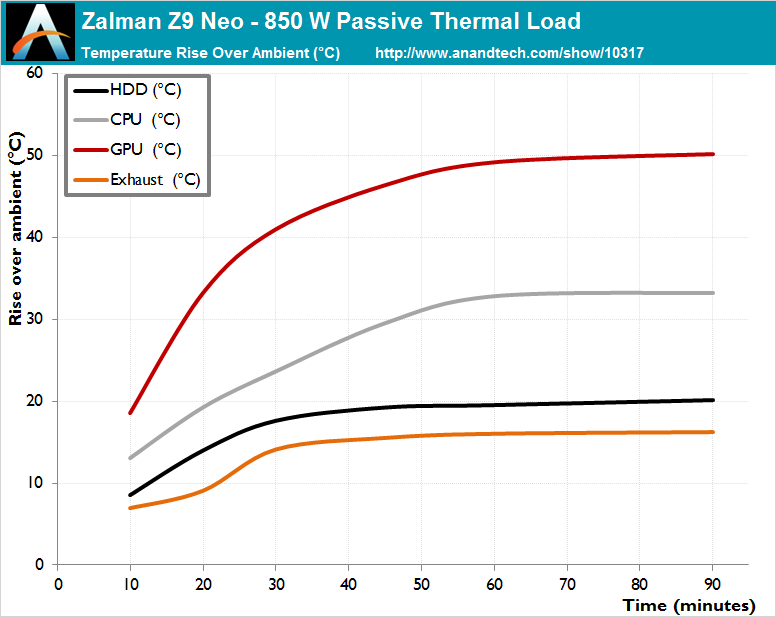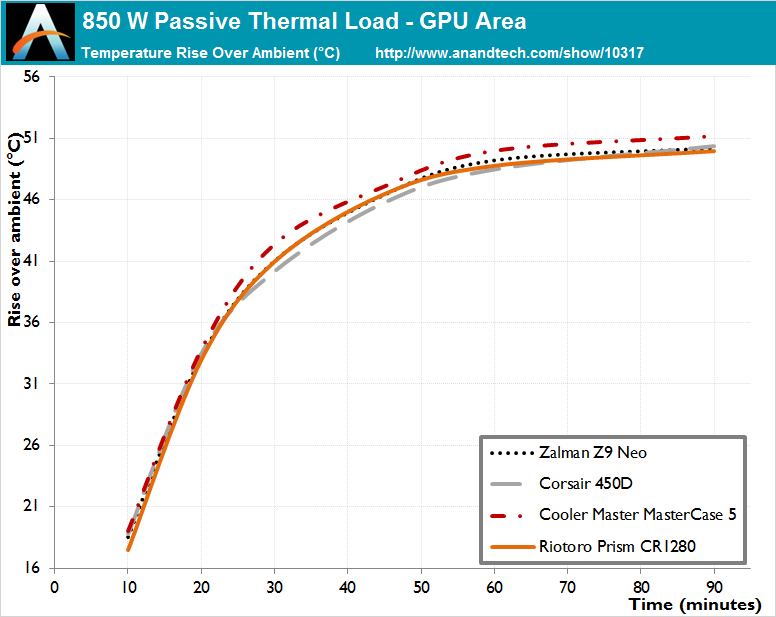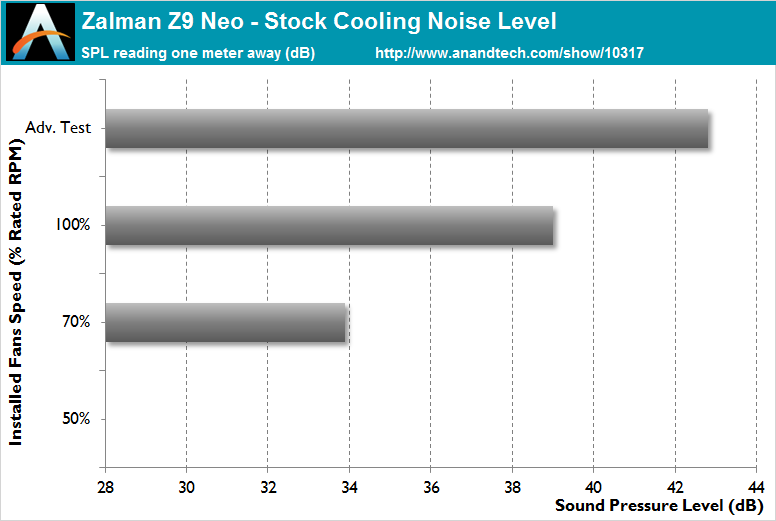The Zalman Z9 Neo Case Review
by E. Fylladitakis on May 20, 2016 9:00 AM EST- Posted in
- Cases/Cooling/PSUs
- Zalman
- ATX
- Case
Test setup
Professional testing requires the emulation of real-world situations but with repeatable results; thus, a perfectly controllable test setup and environment are required, especially for comparable results. Testing the thermal performance of any case with a typical real-world setup technically limits the comparability of the results to this setup alone, as an active system interacts with its environment and the change of a single component would alter myriads of variables. As such, we developed synthetic loads that emulate the thermal output of real systems, which however are passive, steady and quantifiable. As such, the thermal testing now displays the thermal capabilities of the case alone, as if it would have to deal with the entire thermal load by itself, regardless of the system that would be installed inside it. Laboratory data loggers are being used to monitor the PT100 sensors and control the safety relays, which are fully accessible via our custom software. Three such loads have been developed; the ATX version simulates a 200W CPU, 50W VRM, 30W RAM and 4 × 120W GPU card thermal load. Finally, three 3.5" HDD dummy loads have also been created, with each of them converting 30 W of electrical power to thermal, bringing the total thermal load of the ATX test setup up to 850 Watts. As such, the thermal load is immense and only the best of cases will be able to handle it for more than a few minutes, we are also performing a test with a thermal load of 400W, with all of the aforementioned components except the HDD drives at about 42% power, which is more suitable for the majority of cases.
Thermal testing has been performed with all of the case's stock fan operating at maximum speed. Noise testing has been performed with a background noise level of 30.4dB(A). Advanced noise testing is also being performed, in order to assess the ability of the case to dampen the noise of the components installed inside it. This includes the installation of two noise-generating sources (strong fans) inside the case, one positioned approximately over the first expansion slot and one over the CPU area, which generate ≈ 44.2 dB(A) when unobstructed. During the advanced noise test, all stock cooling options of the case are entirely disabled.
Results and discussion
The Zalman Z9 Neo delivered very good thermal performance for a case of its class and price range, outperforming much more expensive and spacious cases, such as the Cooler Master MasterCase 5 and the Corsair 450D. This is not because of a unique thermal design, but due to Zalman installing five stock fans into their case. Five low speed fans can deliver very high air volume flow and are in fact much more efficient than just one or two strong fans.
Although we expected that the Zalman Z9 Neo would not be entirely silent with five stock fans installed into it, our test results were much better than we expected. With the fans running at maximum speed, the Zalman Z9 Neo is audible, but the noise level is tolerable for everyday use. The five fans that Zalman is using are low speed models and thus their maximum performance is limited, but they move substantial amounts of air with low aerodynamic drag, keeping noise figures relatively low. The side effect is that these fans cannot have their speed reduced too much or they stop, which is why we were not able to test them at 50% speed.
Zalman’s choice to install a sound dampening layer at the front panel of the Z9 Neo does not seem to be paying off. The Z9 Neo has many openings and the layer seems to be ineffective, as the figures that we got from our advanced noise testing hint that the sound dampening capabilities of the case are minimal.















30 Comments
View All Comments
HollyDOL - Friday, May 20, 2016 - link
Oh, my tomcat would definitely love this case... especially those little USB inserts. I'd give it about half hour tops before being discovered and ... privatized :-)HollyDOL - Friday, May 20, 2016 - link
Not to sound ironic, it seems like a good case, esp. related to the cost.Flunk - Friday, May 20, 2016 - link
What does that have to do with it not being cat-proof?I think you'd be ok if you removed the transparent section on the top and didn't use the port covers. The other parts are a bit big for a cat to make off with. Although I say that, my cat has stolen my razer and hidden it before.
Haravikk - Tuesday, May 24, 2016 - link
Get rid of the cat; problem solved.No really, pet-related problems are the fault of having a pet, not products being designed around pets. Cat hair is one of the worst things for computers in general, so get rid of the cat and you not only save a ton of money, but solve that problem completely.
JoeyJoJo123 - Wednesday, May 25, 2016 - link
How about you get rid of that disgusting attitude you have towards other animal species?I have 4 adopted cats I take care of, not because I went to an adoption center, but because of crappy people like you who leave them abandoned on the street, with no home, no shelter, and no food. Just like me or you, cats didn't ask to be born. They just do their best to live another day. I was gracious enough to accept not one, not two, not three, but four abandoned pets from my neighborhood and gave them a loving home.
Also, cat hair isn't an issue. Regular vacuuming and A/C filter replacements takes care of that issue. It's a matter of PEBCAK. In other words, you're too lazy to vacuum (whereas you should regardless of whether you have pets or not) and you're too lazy to replace A/C filters throughout your home on a regular basis.
flyingpants265 - Tuesday, April 2, 2019 - link
Whoa, not often you see someone that delusional.MadAd - Friday, May 20, 2016 - link
I'm constantly amazed how much full size ATX is still used.Kepe - Friday, May 20, 2016 - link
Why? mATX and mITX motherboards support 0 expandability. For example, I have a fast PCIe SSD and a PCIe sound card. And of course a PCIe GPU, and room for even more stuff. Also, I have support for SLI and CrossFire. You couldn't have those on a smaller motherboard. mATX has its place in the market, for people who want to build as small a PC as possible, or for those who want a living room media PC.Black Obsidian - Friday, May 20, 2016 - link
All of your points are true, but also irrelevant for (I would guess) north of 90% of all users, who need 0 expandability. SLI is relatively rare, PCIe sound cards rarer still. And yet full ATX remains the most common form factor.IMO, it's motherboard selection that's holding people back more than cases. I have one CPU, one high-end GPU, one PCIe M.2 SSD, and no expectation of ever needing any additional PCIe slots... and yet I have a full-ATX motherboard, because Asus didn't offer any mATX motherboards with the features I wanted.
just4U - Monday, May 23, 2016 - link
I'd say it's not Motherboard selection.. We have had some variety for awhile now.. What's lacking is casing... casing.. casing. Can't stress that enough.I'd kill for a good ole lian-li type PC-60 without all the 5.25 drive bays /w a wider chassis to accommodate 120MM fans.. and cable management.. provided it had the old school removable MB Tray..
Can think of about 50 other cases out there that would be great sellers to if these case makers would just shrink them down for the Mitx market..It's not rocket science to know what works and what doesn't.